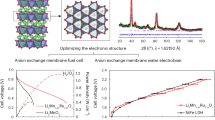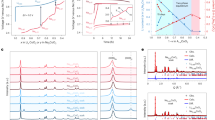Abstract
Ammonia is an important industrial chemical and is also being discussed as a potential energy carrier. Electrifying ammonia synthesis could help to decarbonize the chemical industry, as the Haber–Bosch process contributes markedly to global carbon emissions. A lithium-mediated pathway is among the most promising ambient-condition electrochemical ammonia synthesis methods. However, the role of metallic lithium and its passivation layer, the solid electrolyte interphase (SEI), remains unresolved. Here we use cryogenic transmission electron microscopy as part of a multiscale approach to explore lithium reactivity and the SEI, discovering that the proton donor (for example, ethanol) governs lithium reactivity towards nitrogen fixation. Without ethanol, the SEI passivates lithium metal, rendering it inactive for nitrogen reduction. Ethanol disrupts this passivation layer, enabling continuous reactivity at the lithium surface. As a result, metallic lithium is consumed via reactions with nitrogen, proton donor and other electrolyte components. This reactivity across the SEI is vital to device-level performance of lithium-mediated ammonia synthesis.
This is a preview of subscription content, access via your institution
Access options
Access Nature and 54 other Nature Portfolio journals
Get Nature+, our best-value online-access subscription
$29.99 / 30 days
cancel any time
Subscribe to this journal
Receive 12 digital issues and online access to articles
$119.00 per year
only $9.92 per issue
Buy this article
- Purchase on Springer Link
- Instant access to full article PDF
Prices may be subject to local taxes which are calculated during checkout





Similar content being viewed by others
Data availability
The data collected and analysed for this work are included in the paper and its Supplementary Information. Source data are provided with this paper.
References
MacFarlane, D. R. et al. A roadmap to the ammonia economy. Joule 4, 1186–1205 (2020).
Erisman, J. W., Sutton, M. A., Galloway, J., Klimont, Z. & Winiwarter, W. How a century of ammonia synthesis changed the world. Nat. Geosci. 1, 636–639 (2008).
World Fertilizer Trends and Outlook to 2022 (FAO, 2019).
Maxwell, G. R. Synthetic Nitrogen Products (Kluwer Academic Publishers, 2004).
Smith, C., Hill, A. K. & Torrente-Murciano, L. Current and future role of Haber–Bosch ammonia in a carbon-free energy landscape. Energy Environ. Sci. 13, 331–344 (2020).
Appl, M. in Ullmann’s Encyclopedia of Industrial Chemistry 139–225 (2011).
Chen, J. G. et al. Beyond fossil fuel-driven nitrogen transformations. Science 360, eaar6611 (2018).
Soloveichik, G. Electrochemical synthesis of ammonia as a potential alternative to the Haber–Bosch process. Nat. Catal. 2, 377–380 (2019).
Comer, B. M. et al. Prospects and challenges for solar fertilizers. Joule 3, 1578–1605 (2019).
Schiffer, Z. J. & Manthiram, K. Electrification and decarbonization of the chemical industry. Joule 1, 10–14 (2017).
Ludwig, T., Singh, A. R. & Nørskov, J. K. Subsurface nitrogen dissociation kinetics in lithium metal from metadynamics. J. Phys. Chem. C. 124, 26368–26378 (2020).
Tsuneto, A., Kudo, A. & Sakata, T. Efficient electrochemical reduction of N2 to NH3 catalyzed by lithium. Chem. Lett. 22, 851–854 (1993).
Tsuneto, A., Kudo, A. & Sakata, T. Lithium-mediated electrochemical reduction of high pressure N2 to NH3. J. Electroanal. Chem. 367, 183–188 (1994).
Lazouski, N., Schiffer, Z. J., Williams, K. & Manthiram, K. Understanding continuous lithium-mediated electrochemical nitrogen reduction. Joule 3, 1127–1139 (2019).
Andersen, S. Z. et al. A rigorous electrochemical ammonia synthesis protocol with quantitative isotope measurements. Nature 570, 504–508 (2019).
Greenlee, L. F., Renner, J. N. & Foster, S. L. The use of controls for consistent and accurate measurements of electrocatalytic ammonia synthesis from dinitrogen. ACS Catal. 8, 7820–7827 (2018).
Lazouski, N., Chung, M., Williams, K., Gala, M. L. & Manthiram, K. Non-aqueous gas diffusion electrodes for rapid ammonia synthesis from nitrogen and water-splitting-derived hydrogen. Nat. Catal. 3, 463–469 (2020).
Suryanto, B. H. R. et al. Nitrogen reduction to ammonia at high efficiency and rates based on a phosphonium proton shuttle. Science 372, 1187–1191 (2021).
Li, K. et al. Enhancement of lithium-mediated ammonia synthesis by addition of oxygen. Science 374, 1593–1597 (2021).
Fichter, F., Girard, P. & Erlenmeyer, H. Elektrolytische bindung von komprimiertem stickstoff bei gewöhnlicher temperatur. Helv. Chim. Acta 13, 1228–1236 (1930).
Andersen, S. Z. et al. Increasing stability, efficiency, and fundamental understanding of lithium-mediated electrochemical nitrogen reduction. Energy Environ. Sci. 13, 4291–4300 (2020).
Cai, X. et al. Lithium-mediated electrochemical nitrogen reduction: mechanistic insights to enhance performance. iScience 24, 1–17 (2021).
Schwalbe, J. A. et al. A combined theory–experiment analysis of the surface species in lithium-mediated NH3 electrosynthesis. ChemElectroChem 7, 1542–1549 (2020).
Peled, E. The electrochemical behavior of alkali and alkaline earth metals in nonaqueous battery systems—the solid electrolyte interphase model. J. Electrochem. Soc. 126, 2047–2051 (1979).
Peled, E. & Menkin, S. Review—SEI: past, present and future. J. Electrochem. Soc. 164, A1703–A1719 (2017).
Cheng, X. B. et al. A review of solid electrolyte interphases on lithium metal anode. Adv. Sci. 3, 1500213 (2016).
Zachman, M. J., Tu, Z., Choudhury, S., Archer, L. A. & Kourkoutis, L. F. Cryo-STEM mapping of solid–liquid interfaces and dendrites in lithium-metal batteries. Nature 560, 345–349 (2018).
Li, Y. et al. Correlating structure and function of battery interphases at atomic resolution using cryoelectron microscopy. Joule 2, 2167–2177 (2018).
Lazouski, N. et al. Proton donors induce a differential transport effect for selectivity toward ammonia in lithium-mediated nitrogen reduction. ACS Catal. 12, 5197–5208 (2022).
Cherepanov, P. V., Krebsz, M., Hodgetts, R. Y., Simonov, A. N. & MacFarlane, D. R. Understanding the factors determining the Faradaic efficiency and rate of the lithium redox-mediated N2 reduction to ammonia. J. Phys. Chem. C. 125, 11402–11410 (2021).
Li, Y. et al. Atomic structure of sensitive battery materials and interfaces revealed by cryo-electron microscopy. Science 358, 506–510 (2017).
Zhang, Z. et al. Capturing the swelling of solid-electrolyte interphase in lithium metal batteries. Science 375, 66–70 (2022).
Verdouw, H., Van Echteld, J. A. & Dekkers, E. M. L. Ammonia determination based on indophenol formation with sodium salicylate. Water Res. 12, 399–402 (1977).
Adams, B. D. et al. Accurate determination of coulombic efficiency for lithium metal anodes and lithium metal batteries. Adv. Energy Mater. 8, 1702097 (2018).
Xiao, J. et al. Understanding and applying Coulombic efficiency in lithium metal batteries. Nat. Energy 5, 561–568 (2020).
Mehta, R. in Scanning Electron Microscopy (ed. Kazmiruk, V.) 17–30 (InTech, 2012).
Wang, F. et al. Chemical distribution and bonding of lithium in intercalated graphite: identification with optimized electron energy loss spectroscopy. ACS Nano 5, 1190–1197 (2011).
Aurbach, D., Daroux, M. L., Faguy, P. W. & Yeager, E. Identification of surface films formed on lithium in dimethoxyethane and tetrahydrofuran solutions. J. Electrochem. Soc. 135, 1863–1871 (1988).
Kanamura, K., Tamura, H., Shiraishi, S. & Takehara, Z. XPS analysis of lithium surfaces following immersion in various solvents containing LiBF4. J. Electrochem. Soc. 142, 340–347 (1995).
Zhuang, G. R., Wang, K., Chen, Y. & Ross, P. N. Study of the reactions of Li with tetrahydrofuran and propylene carbonate by photoemission spectroscopy. J. Vac. Sci. Technol. A 16, 3041–3045 (1998).
Andersson, E. K. W. et al. Early-stage decomposition of solid polymer electrolytes in Li-metal batteries. J. Mater. Chem. A 9, 22462–22471 (2021).
Parimalam, B. S. & Lucht, B. L. Reduction reactions of electrolyte salts for lithium ion batteries: LiPF6, LiBF4, LiDFOB, LiBOB, and LiTFSI. J. Electrochem. Soc. 165, A251–A255 (2018).
Wood, K. N. & Teeter, G. XPS on Li-battery-related compounds: analysis of inorganic SEI phases and a methodology for charge correction. ACS Appl. Energy Mater. 1, 4493–4504 (2018).
Li, Y. et al. Revealing nanoscale passivation and corrosion mechanisms of reactive battery materials in gas environments. Nano Lett. 17, 5171–5178 (2017).
Han, B. et al. Poor stability of Li2CO3 in the solid electrolyte interphase of a lithium-metal anode revealed by cryo-electron microscopy. Adv. Mater. 33, 2100404 (2021).
Smith, R. L. & Miser, J. W. Compilation of the Properties of Lithium Hydride (NASA, 1963).
Aurbach, D. & Weissman, I. On the possibility of LiH formation on Li surfaces in wet electrolyte solutions. Electrochem. Commun. 1, 324–331 (1999).
Boyle, D. T. et al. Corrosion of lithium metal anodes during calendar ageing and its microscopic origins. Nat. Energy 6, 487–494 (2021).
Stevie, F. A., Garcia, R., Shallenberger, J., Newman, J. G. & Donley, C. L. Sample handling, preparation and mounting for XPS and other surface analytical techniques. J. Vac. Sci. Technol. A 38, 063202 (2020).
Acknowledgements
K.M., K.S. N.L., and C.K.K. gratefully acknowledge support by the National Science Foundation under grant number 2204756. K.S. and N.L. acknowledge support from the National Science Foundation Graduate Research Fellowship under grant number 1745302. Cryo-EM data were acquired at the Electron Imaging Center for Nanomachines (EICN) at the University of California, Los Angeles’s California NanoSystems Institute (CNSI). Y.L. and X.Y. were supported in part by the National Science Foundation under grant number CBET-2143677. This work also made use of the MRSEC Shared Experimental Facilities at Massachusetts Institute of Technology (MIT), supported by the National Science Foundation under award number DMR-1419807. We thank the staff scientists at both UCLA EICN and MIT MRSEC for their training and expertise. We also thank M. Wolski of Daramic for providing us with polyporous separator samples, F. Frankel for feedback on figure design and K. Williams, N. Corbin, H. J. Song, G. Junor, G. Hobold and all the members of the Li and Manthiram research groups for productive and helpful discussions.
Author information
Authors and Affiliations
Contributions
K.S., K.M. and Y.L. conceptualized the paper. K.S. developed the experimental methodology for product quantification, sample preparation for imaging and characterization and collection of XPS spectra. X.Y. and Y.L. developed the experimental methodology for SEM and cryo-EM. K.S. performed product quantification, SEM imaging and XPS experiments, and K.S. and C.K. prepared samples for cryo-EM. X.Y. carried out cryo-EM and SEM imaging. Y.L. performed EELS characterization. M.M. advised on microscopy and imaging analysis. C.K. and K.S. performed the validation. K.S. prepared the figures and wrote the original draft of the manuscript and Supplementary Information, and N.L, Y.L., K.M., C.K., X.Y. and K.S. reviewed and edited its contents. K.M. and Y.L. supervised the work.
Corresponding authors
Ethics declarations
Competing interests
The authors declare no competing interests.
Peer review
Peer review information
Nature Energy thanks Matteo Cargnello, Chongmin Wang and the other, anonymous, reviewer(s) for their contribution to the peer review of this work.
Additional information
Publisher’s note Springer Nature remains neutral with regard to jurisdictional claims in published maps and institutional affiliations.
Supplementary information
Supplementary Information
Supplementary Figs. 1–35, Notes 1–12 and Methods.
Supplementary Data 1
Source data for Supplementary Figures.
Source data
Source Data Fig. 2
Statistical source data.
Source Data Fig. 3
Statistical source data.
Source Data Fig. 4
Statistical source data.
Rights and permissions
Springer Nature or its licensor (e.g. a society or other partner) holds exclusive rights to this article under a publishing agreement with the author(s) or other rightsholder(s); author self-archiving of the accepted manuscript version of this article is solely governed by the terms of such publishing agreement and applicable law.
About this article
Cite this article
Steinberg, K., Yuan, X., Klein, C.K. et al. Imaging of nitrogen fixation at lithium solid electrolyte interphases via cryo-electron microscopy. Nat Energy 8, 138–148 (2023). https://doi.org/10.1038/s41560-022-01177-5
Received:
Accepted:
Published:
Issue Date:
DOI: https://doi.org/10.1038/s41560-022-01177-5
This article is cited by
-
Beyond lithium for sustainable ammonia synthesis
Nature Materials (2024)
-
Capturing ion trapping and detrapping dynamics in electrochromic thin films
Nature Communications (2024)
-
High lithium oxide prevalence in the lithium solid–electrolyte interphase for high Coulombic efficiency
Nature Energy (2024)
-
Cascade electrosynthesis of LiTFSI and N-containing analogues via a looped Li–N2 battery
Nature Catalysis (2024)
-
Phenol as proton shuttle and buffer for lithium-mediated ammonia electrosynthesis
Nature Communications (2024)



